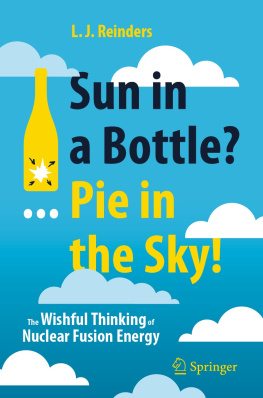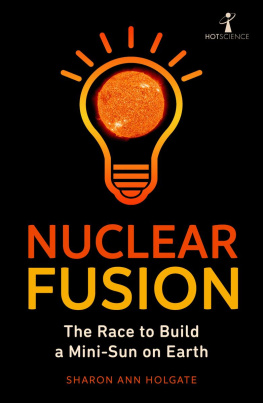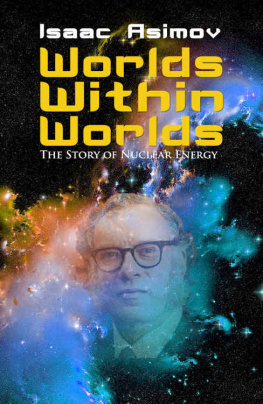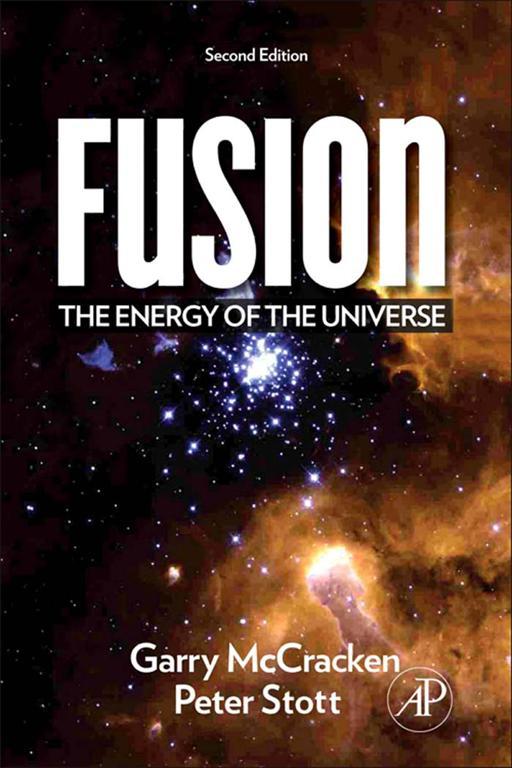Fusion
The Energy of the Universe
Second Edition
Garry McCracken
Peter Stott

Academic Press is an imprint of Elsevier
225 Wyman Street, Waltham, MA 02451, USA
The Boulevard, Langford Lane, Kidlington, Oxford, OX5 1GB, UK
2013, 2005 Elsevier Inc. All rights reserved
No part of this publication may be reproduced or transmitted in any form or by any means, electronic or mechanical, including photocopying, recording, or any information storage and retrieval system, without permission in writing from the publisher. Details on how to seek permission, further information about the Publishers permissions policies and our arrangements with organizations such as the Copyright Clearance Center and the Copyright Licensing Agency, can be found at our website: www.elsevier.com/permissions
This book and the individual contributions contained in it are protected under copyright by the Publisher (other than as may be noted herein).
Notices
Knowledge and best practice in this field are constantly changing. As new research and experience broaden our understanding, changes in research methods, professional practices, or medical treatment may become necessary.
Practitioners and researchers must always rely on their own experience and knowledge in evaluating and using any information, methods, compounds, or experiments described herein. In using such information or methods they should be mindful of their own safety and the safety of others, including parties for whom they have a professional responsibility.
To the fullest extent of the law, neither the Publisher nor the authors, contributors, or editors, assume any liability for any injury and/or damage to persons or property as a matter of products liability, negligence or otherwise, or from any use or operation of any methods, products, instructions, or ideas contained in the material herein.
Library of Congress Cataloging-in-Publication Data
Application submitted
British Library Cataloguing-in-Publication Data
A catalogue record for this book is available from the British Library
ISBN: 978-0-12-384656-3
For information on all Academic Press publications, visit our website: http://store.elsevier.com
Printed in China
12 13 14 9 8 7 6 5 4 3 2 1

To Pamela and Olga, thank you for your continued encouragement and patience.
Technical Summaries
These technical summaries, contained in shaded boxes, are supplements to the main text. They are intended for the more technically minded reader and may be bypassed by the general reader without loss of continuity.
Chapter 2
2.1 The Mass Spectrograph
Chapter 3
3.1 The Neutrino Problem
3.2 The Carbon Cycle
3.3 Cosmic Microwave Background Radiation
3.4 The Triple Alpha Process
3.5 Heavier Nuclei
Chapter 4
4.1 Source of Deuterium
4.2 Tritium Breeding Reactions
4.3 Conditions for Confinement
Chapter 5
5.1 Magnetic Confinement
5.2 Toroidal Confinement
5.3 Linear Confinement
Chapter 7
7.1 Conditions for Inertial Confinement
7.2 Capsule Compression
7.3 The Laser Principle
7.4 Capsule Design
7.5 Fast Ignition
Chapter 8
8.1 Electrolysis
Chapter 9
9.1 Disruptions
9.2 Sawteeth
9.3 Operating a Tokamak
9.4 Temperature Measurement
9.5 Sources of Impurities
9.6 Impurity Radiation
9.7 Production of Neutral Heating Beams
9.8 Radiofrequency Heating
9.9 L- and H-Modes
Chapter 10
10.1 Operating Limits
10.2 Pulse Length and Confinement Time
10.3 Understanding Confinement
10.4 Empirical Scaling
10.5 Stellarators
10.6 Magnetic Surfaces
Chapter 11
11.1 ITER Operating Limits
11.2 Some Changes Resulting from the 2007 Design Review
11.3 Additional Heating
Chapter 12
12.1 Advances in Target Design
12.2 Chirped-Pulse Amplification
12.3 Approaches to Ignition
Chapter 13
13.1 Steady-State versus Pulsed Power Plants
13.2 Radiation Damage
13.3 Low-Activation Materials
13.4 Shielding Superconducting Coils
13.5 Power Handling in the Divertor
13.6 The Broader Approach
13.7 Driver Efficiency and Target Gain
13.8 Diode-Pumped Lasers
13.9 Tritium Breeding
13.10 Alternative Fuels
Foreword to the Second Edition
The imperative for fusion energy grows stronger every year. Concerns increase regarding global climate change, conflicts over natural resources, safety of massively deployed energy production, and the finite supply of energy resources. The need for a safe, carbon-free, abundant energy source is intense. Fusion is one of the very few options for such an energy source.
Over the past fifty years, scientists have developed a new field of science: plasma physics. The core of a fusion energy system is a plasmaa gas of charged particleswhich is superhot, about ten times hotter than the core of the Sun. We now know how to produce, manipulate, and control this state of matter with remarkable finesse. The engineering and technology needed to control plasmas are also mature.
As a result of this fantastic accumulation of knowledge, fusion energy research is now at a turning point. With some reasonable clarity, we can see our way to the endpoint of commercial fusion energy. Both physics and engineering challenges surely remain. But the solutions to these challenges are sufficiently well-envisioned that roadmaps to fusion-on-the-grid have been developed in all nations active fusion research. Across the world, scientists draw a similar conclusion that a full-scale demonstration power plant can be operating in some 2025 years.
The current turning point is also marked by two new, landmark experimentsITER and NIF (the National Ignition Facility). ITER is an experiment in magnetic fusion energy, in which plasmas are confined by strong magnetic fields. Remarkably, the governments of half the worlds population have come together to design, construct, and operate the facility. ITER is designed, as an experiment, to generate about 500 million watts of fusion power for about 500 seconds. It will also produce, for the first time, a self-sustaining, burning plasma in which the plasma is self-heated by the power from the fusion reactions. ITER is under construction in Cadarache, France, and will begin operation around 2020. It will establish, to a large extent, the scientific and technological feasibility of a fusion power plant. NIF is an experiment in inertial fusion energy, recently brought into operation at the Lawrence Livermore National Laboratory in the US. NIF implodes a tiny pellet of frozen fusion fuel by immense lasers, causing a release of fusion energy in a fraction of a billionth of a second. Experiments are now underway to produce an ignited plasma in which fusion begins in the pellet core and propagates throughout the pellet.
This is an opportune moment to look back at the deep understanding of fusion plasma science that has accrued over the decades. This science has given us our designs of fusion power plants, but also has enormous impact on other fields of physics and technology, from the plasma cosmos to plasmas used to process computer chips. At this same moment, we can look ahead to how we will overcome the scientific hurdles to fusion. Thus, I am very pleased that the second, updated edition of this comprehensive and authoritative book by Garry McCracken and Peter Stott is now appearing, with new chapters on ITER and NIF.










